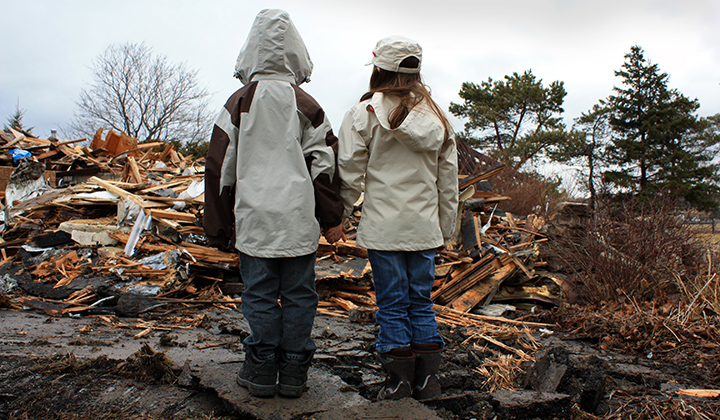
Spring can’t come soon enough after months of winter cold and darkness. But with spring comes severe weather and tornados which can cause dangerous conditions and sometimes lead to injuries. What does your family need to stay safe during severe weather? Check out these tips for tornado safety.
1. Make a plan. The first and most important tip for tornado safety is to make sure your family has a plan. When the tornado siren goes off, everyone in the family should know where to go and what to do. Preparation is key. Practice tornado drills the same way you practice fire drills in your home. Practice, practice, practice.
In the event of severe weather, all members of the family should put on shoes. Kids can also wear bike helmets to help prevent head injuries. The entire family, including pets and service animals, should seek shelter.
One important element of the plan is a meeting place. Emergencies can be chaotic – especially tornados or storms that may cause damage to your home. Plan ahead and agree on a meeting place to find family members who may get lost or separated during the storm.
2. Know your weather words. Knowing the difference between the weather terms is important. A tornado watch means conditions are favorable for a tornado in your area. A tornado warning means a tornado has been spotted and is on the ground. Start taking action during the tornado watch because a tornado watch can turn into a tornado warning very quickly. Don’t wait for the worst weather – be proactive! Get to a safe place as soon as possible.
3. Take shelter. Get to a safe space as soon as the tornado watch starts. The safest place is in the basement of your home, or a below-ground tornado shelter. If a basement or shelter is not available, go to the most interior room of the house. Stay away from windows. In some cases, the bathroom is the safest place to take shelter. The more walls between your family and the outside, the safer your family will be. Get into the bathtub and cover yourself with towels, blankets or pillows to avoid injuries caused by falling or swirling debris. Cover your head and neck area to protect yourself, if necessary.
4. Wait for the all-clear. Typically, there is no all-clear signal from most county emergency sirens. During a tornado warning, sirens will sound until the warning expires. Stay in your safe place until the all-clear signal from the news. Tornados are usually on the trailing end of storms – they aren’t the first thing coming your way. Don’t assume it’s safe to go outside because the worst of the storm has passed. The all-clear signal is the only signal that it’s safe. Make sure you have a way to monitor the weather and hear the all-clear signal – like a weather radio.
Speaking of all clear, remember those shoes the whole family put on? Wearing shoes will help prevent cuts and scrapes from broken glass, debris and other storm damage.
5. Check-in. After the all-clear signal, make sure all members of the family are safe and accounted for. Call 9-1-1 for any life-threatening injuries.
Your family safety plan should include several items for the storm shelter:
- Weather radio. A radio or weather app will help track the storm and let you know when it’s all clear. Make sure your device is fully charged or has backup power.
- Water. Plan to have enough water to get the entire family through 3 days, if needed (1 gallon per person, per day).
- Non-perishable food. Plan to have enough food to sustain the entire family for 3 days, if needed.
- First aid kit. Keep one in the shelter or basement or have it on hand to grab during severe weather.
- Bring any medications anyone in your family takes regularly with you to the shelter.
- Hand sanitizer. A storm or tornado may limit your family’s access to clean running water. Hand sanitizer helps prevent the spread of germs and disease.
- Light source. A battery-operated or crank flashlight will come in handy if you lose power during the storm.
Tornados and severe storms can be scary for kids and parents alike. But with some preparation and planning, you can help keep your family safe. If you don’t have one already, make a safety plan and practice it with your family.
For more information, visit the Center for Childhood Safety at Children’s Mercy.

